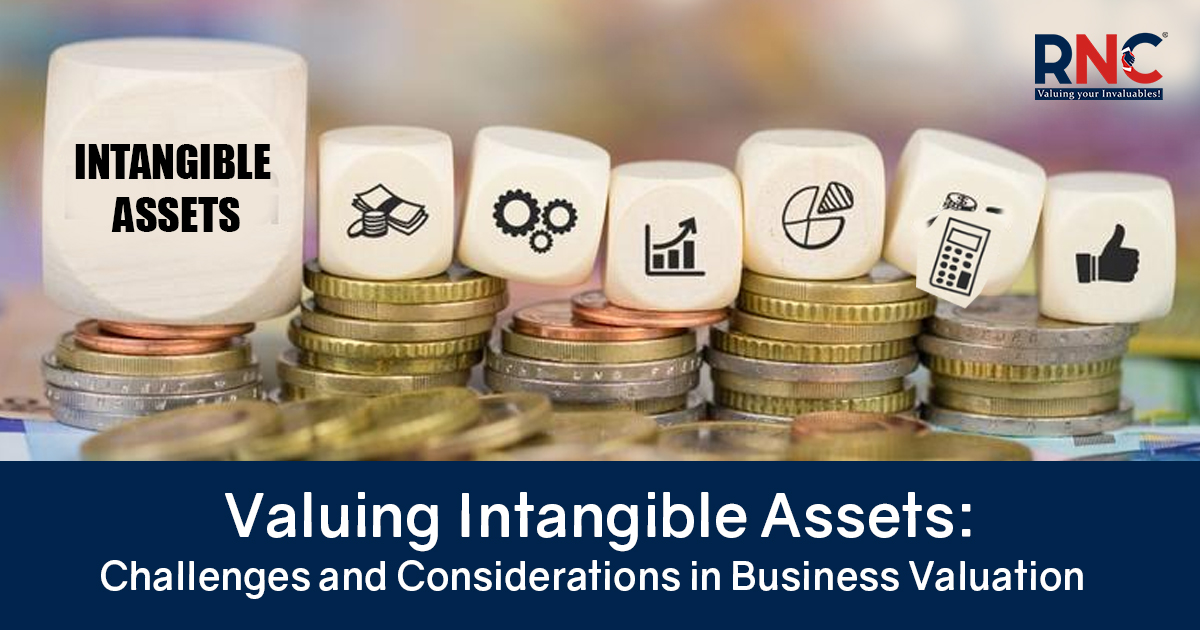
Intangibles drive most enterprise value—brands, patents, software, data, and know-how. In 2025, investors and auditors expect defensible intangible valuations that align with Ind AS/IFRS and deal realities. This guide explains when to value, which method to use, and how to defend your number in diligence.
In the world of business, determining the value of assets is a crucial component of financial decision-making. However, while tangible assets such as property and equipment are relatively straightforward to evaluate, intangible assets present a unique set of challenges. Intangible asset valuation has emerged as a vital aspect of business valuation, requiring careful consideration and expertise. In this blog, we will delve into the complexities and considerations surrounding intangible asset valuation, shedding light on its significance in assessing the true worth of a business.
Understanding Intangible Assets
Intangible assets, unlike their tangible counterparts, lack physical substance. These assets derive their value from non-physical attributes such as intellectual property, brand recognition, customer relationships, and proprietary technology. Examples of intangible assets include patents, copyrights, trademarks, trade secrets, goodwill, and software.
Read More: Property Investment without Valuation is Shooting Blindly in the Real Estate Market
Challenges in Intangible Asset Valuation
Lack of standardization:
Unlike financial statements and tangible assets, there is no standardized method for assets valuation. Various approaches, including cost, market, and income-based methods, are used, but they often require adaptations to suit the specific nature of each intangible asset.
Subjectivity and uncertainty:
Intangible asset valuation relies heavily on assumptions and forecasts, which introduces subjectivity and uncertainty into the process. Estimating future cash flows, determining the useful life of an asset, and assessing market demand for a particular brand are all subjective judgments that can affect the valuation outcome.
Data availability and reliability:
Gathering reliable data for intangible asset valuation can be challenging. Publicly available information may be limited, and proprietary data held by the company might not be easily accessible. Additionally, the accuracy and reliability of the data can also pose concerns, particularly when valuing emerging or unique intangible assets.
Read More: Want to Sell Your Business? Company Valuation Expert Tips for You
Considerations in Intangible Asset Valuation
To overcome the challenges associated with intangible asset valuation, businesses should consider the following factors:
Expertise and Professional Guidance
Engaging experienced professionals with expertise in business valuation and intangible asset assessment is essential. Their knowledge and understanding of valuation methodologies can provide valuable insights and ensure an accurate assessment.
Comprehensive Asset Identification
It is crucial to identify and document all intangible assets within the business. This includes trademarks, patents, copyrights, customer relationships, and proprietary technology. Comprehensive asset identification helps avoid undervaluing or overlooking important intangible assets.
Ongoing Monitoring and Valuation Updates
Intangible asset valuation is an ongoing process that requires regular monitoring and updates. Reassessing the value of intangibles periodically ensures alignment with market dynamics and changes within the business.
Conclusion:
Valuing intangible assets is a complex process that requires careful consideration and expertise. Business valuation must go beyond the traditional focus on tangible assets and encompass the significant contributions that intangible assets make to a company’s value. By addressing the challenges and taking into account the various considerations involved, businesses can gain a more accurate understanding of their intangible assets’ worth, facilitating informed decision-making and strategic planning for the future.
Remember, successfully valuing intangible assets not only provides insights into a company’s current value but also helps identify areas for growth and potential risks.
Read More :
Learn About Asset Valuation and How It Works
FAQS:
1. Which method is best to value a brand?
The Relief-from-Royalty (RFR) method is most suitable for brand valuation. It applies a market-based royalty rate to brand revenues, then adjusts for taxes and discounts to present value.
2. When should I use the MPEEM method?
Use the Multi-Period Excess Earnings Method (MPEEM) when valuing technology, customer relationships, or software that generate identifiable cash flows after contributory asset charges.
3. Can I value early-stage IP without revenues?
Yes. For patents, R&D, or tech assets without cash flows, the Cost or Replacement approach is used. It estimates the cost to recreate the asset, adjusted for obsolescence and commercialization risk.
4. Are intangible valuations acceptable for audit in India?
Yes. They are accepted if aligned with Ind AS 36/38 and IFRS, backed by defendable assumptions, sensitivity analysis, and reliable market benchmarks.
5. What documents improve the defensibility of intangible valuations?
Supporting documents include royalty rate studies, product roadmaps, financial projections, contributory asset charge calculations, and sensitivity analysis of growth and discount rates.

About the author:
Sahil Narula
Sahil Narula is the Managing Partner at RNC Valuecon LLP and a Registered Valuer with IBBI. He brings over a decade of experience in Valuation Services, Corporate Finance, and Advisory, having led numerous complex assignments under the Insolvency & Bankruptcy Code, 2016, Mergers & Acquisitions, Insurance, and Financial Reporting.
He is a regular speaker at national forums (ASSOCHAM, CII, ICAI, IBBI, Legal Era) and currently serves as Co-Chairman of ASSOCHAM’s National Council on Insolvency & Valuations and a member of CII’s Task Force on Insolvency & Bankruptcy.
🤝Connect with Sahil on LinkedIn.
